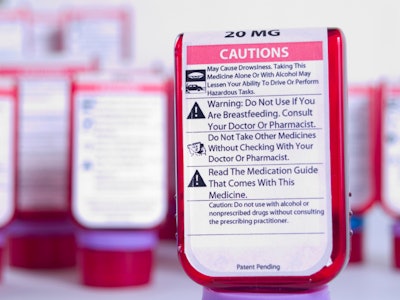
Word on the street has it that Pharmapack Europe has outgrown its current location and will relocate in 2014.
As one exhibitor told me, “when it comes to Europe, it’s the only game in town.”
True, there are more stands than ever. But this year’s educational program was dominated by suppliers. However, two non-commercial presenters began the day.
David Dronneau, Innovation and Technology head in R&D Clinical Supplies from Sanofi, talked about safety and compliance. It’s a bit of a dilemma, he said, when safety features make the drug more difficult to take.
Yes, the package must protect the drug during shipping, and offer barriers to moisture, light, and oxygen. But the package must be patient–centric as well.
The package should protect caregivers too, and offer labeling that is clear and easy to read. Often not enough is done to meet patient expectations.
In fact, says, Dronneau, one out of every two patients do not comply with drug-taking instructions, whatever the disease.
Information must be understandable, clearly readable, accessible, and updated frequently. Tiny type on multi-page inserts or crude pictograms should be enhanced by newer technology like videos launched by QR codes on your phone.
Dronneau cited research that shows seniors, in particular, struggle with packaging and the battle gets worse as they age. Half of those 60 to 70 years old report difficulties. The number of those struggling with packaging grows to 60% for 70 to 80 year-olds and 66% for those 80 or older. That’s half to two-thirds of seniors still complaining—hard to believe after all the studies, focus groups, package design workshops, etc.
The difficulty is balancing regulatory requirements, symptoms of disease (poor eyesight, stiff joints) and an explosion of new devices complicating the landscape.
Different disabilities offer different challenges. Package design must include real-life testing, especially with the trend to do more at home, usability is of fundamental importance.
Dronneau cited Advil as an example of a drug offered in two different packages, one for seniors with easy-open features, and one package that requires more work to access for households with children.
“I firmly believe we will end up with personalized packaging,” said Dronneau. “We talk about customized medicine, why not customized packaging?”
Later, during Q and A, an audience member from Merck commented on this vision of personalized packaging, stating, “Adults, seniors, children, countries, regions, etc. I can see the number of SKUs expanding and this could create a lot of scrap. Industry does not like to develop these kinds of products because the returns are lower.”
A dilemma indeed
Next up was hospital pharmacist Dr. Olivier Bourdon who told the audience, “A pharmacist wants everything with a package.”
The package should perform the following functions:
• Increase drug adherence
• Offer security both at home and in the hospital
• Improve communication between patient and pharmacist
• Be informative for good dispensing
• Be informative for drug storage at home and in the pharmacy
• Not confuse one drug with another
• Provide information in large letters
• Not have too much text
• Be small enough to be discreet
“We don’t like spoons for pediatrics,” he said. “Tilt the spoon slightly and you change dosage. Single unit-dose packaging is much better than spoons.
“Packages are often too large and when we have to repackage, it creates a lot of waste.
“Information for proper dispensing, age, weight, etc., should be very visible. Also, I would like to know shelf life after opening. Often the hospital is storing a drug in the refrigerator and it is not supposed to be. Or it is supposed to be refrigerated and the patient takes it home not knowing this.
“You’ve got a carton with top, sides, back, and bottom. Where is the pertinent information? Or, two patches for completely different uses, using very similar packaging.
“There is often too much text and the package is not discreet for the patient to carry around. A unit dose is always better than a big bottle of tablets.
“We need to adapt packaging for multilingual use. Maybe some day you will click and only see the information you need, in your own language, with an integrated video showing actual use.
“If you can do all this, balance beauty with use, then you are the package for me!”
Note: This was the second mention of incorporating videos. Is anyone doing this yet? Why isn’t Youtube teaching us proper dispending tips for better adherence?
By the numbers
• Organized crime loves counterfeit drugs, largely due to the huge profit potential and relatively lenient penalties.
• MAN Roland recently estimated if a criminal organization invests $1,000, the return on investment for the following crimes would be…
Money laundering: $3,300
Heroin: $20,000
Smuggling cigarettes: $43,000
Counterfeit software: $100,000
Counterfeit drugs: $500,000





















